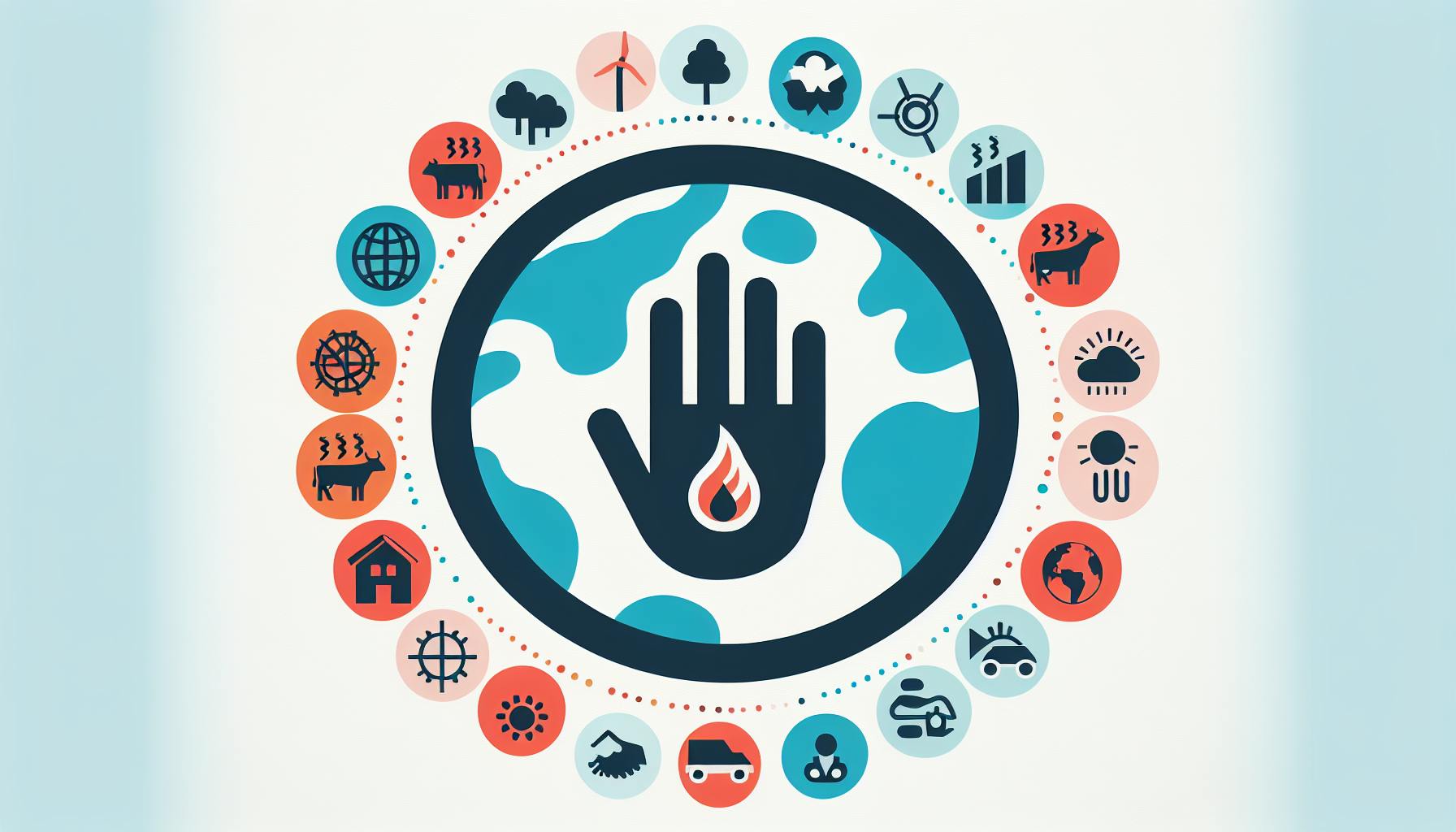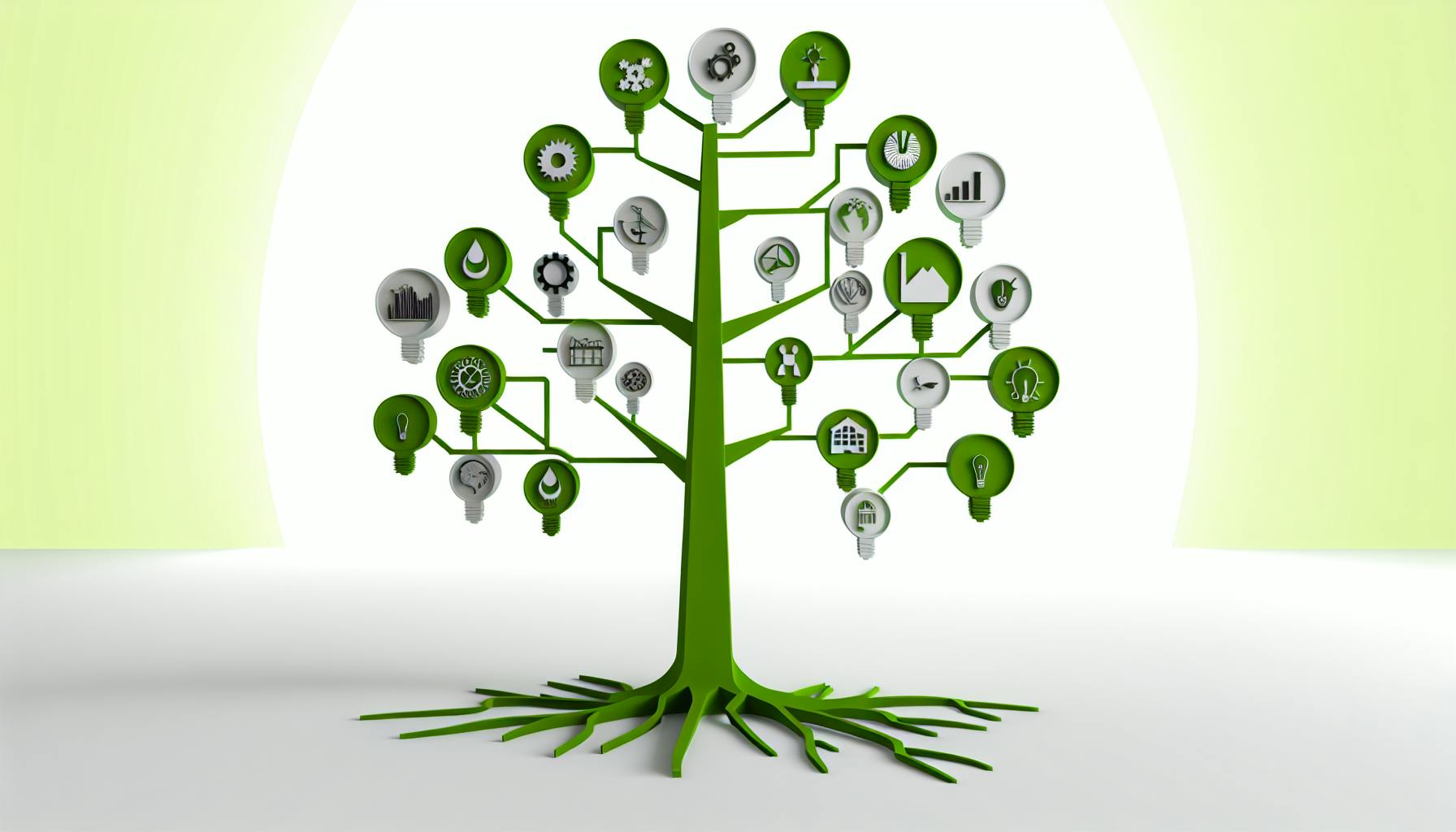With growing stakeholder pressure and emerging legislation, sustainability and carbon reporting can seem daunting for SMEs.
However, by focusing on the fundamentals, carbon tracking and communication becomes more manageable.
In this post, we'll demystify the essentials of sustainability carbon reporting, including straightforward methods for measurement, reduction strategies, and articulating efforts to key stakeholders.
Demystifying Sustainability and Carbon Reporting for SMEs
Sustainability and carbon reporting have become increasingly important for small and medium-sized enterprises (SMEs). With rising stakeholder expectations and evolving legislation around climate change, measuring and disclosing carbon emissions transparently is no longer optional. This article will clarify what carbon reporting means, why tracking carbon matters for SMEs, and how regulations and stakeholders are influencing the need for robust carbon reporting.
Defining Sustainability, Carbon and Their Growing Relevance
Carbon reporting refers to measuring and reporting on the greenhouse gas (GHG) emissions generated by a company's operations and value chain. More specifically, it constitutes the carbon dioxide equivalent (CO2e) emissions derived from activities across an organisation's direct operations and broader supply chain. With climate change concerns mounting globally, carbon reporting has become a focal point for sustainable and socially responsible business practices.
Although large corporations have been reporting on sustainability & ESG issues for years, SMEs are now facing increasing pressure from multiple sides to measure and disclose emissions. Key reasons why tracking carbon matters for SMEs include:
-
Complying with current and emerging climate-related regulations
-
Meeting investor and customer expectations for emissions transparency
-
Boosting brand reputation via sustainability communications
-
Identifying opportunities to reduce costs through energy efficiency
-
Contributing positively to urgent global decarbonisation efforts
As stakeholders ramp up calls for climate action, the ability to accurately account for carbon is becoming integral to responsible SME leadership.
Legislation and Stakeholder Influence on Carbon Reporting
Various interlinking forces are causing a surge in mandatory sustainability carbon reporting for SMEs. These stem from both top-down regulatory requirements as well as bottom-up demands from stakeholders.
In terms of regulation, government policies around climate disclosure are accelerating quickly. Frameworks like the EU's Corporate Sustainability Reporting Directive (CSRD) will soon require carbon reporting from most SMEs in Europe. Such legislation reflects how sustainability metrics are being embedded into financial reporting standards worldwide.
Additionally, powerful stakeholders are pressurising SMEs to provide emissions transparency. Major investors now screen companies based on their carbon footprints before making investment decisions. Many large corporations also assess supplier sustainability, with carbon measurement a key prerequisite for small businesses to access such lucrative supply chain contracts.
With carbon reporting becoming inextricable from normal business compliance, reliable sustainability accounting is crucial for SMEs to remain competitive. Failing on transparency can jeopardise financing, partnerships and market opportunities. By contrast, leadership in emissions reporting enables access to growing green investment flows while satisfying evolving stakeholder and regulatory demands.
What is carbon in sustainability?
Sustainability has become a top priority for many businesses. An important part of managing sustainability efforts is understanding and reducing your carbon footprint.
Your carbon footprint represents the total greenhouse gases emitted from your business operations. It is measured in carbon dioxide equivalent (CO2e) units. The main greenhouse gases that contribute to a carbon footprint are:
-
Carbon dioxide (CO2) from burning fossil fuels
-
Methane (CH4) from agriculture and waste
-
Nitrous oxide (N2O) from industrial processes
To calculate your carbon footprint, you need to look at emissions from across your entire value chain. This includes:
-
Direct emissions from owned or controlled sources like facilities, vehicles, and equipment (Scope 1 emissions)
-
Indirect emissions from purchased electricity and heating (Scope 2 emissions)
-
Other indirect emissions from business travel, distribution, waste disposal etc. (Scope 3 emissions)
Once you have a baseline measurement for your carbon footprint, you can start to implement reductions. Common ways businesses reduce their sustainability carbon footprint include:
-
Improving energy efficiency in buildings and transport
-
Switching to renewable energy sources
-
Changing procurement policies to favour low-carbon goods and services
-
Offsetting remaining unavoidable emissions
Regularly tracking and reporting your carbon footprint is key for demonstrating progress to stakeholders. Automated software can simplify this sustainability carbon accounting process for small and medium enterprises.
Focusing on sustainability carbon enables businesses to lower costs, comply with regulations, meet stakeholder expectations and build resilience for the future. It is an integral part of planning for net zero emissions.
What is the carbon equivalent sustainability?
The carbon equivalent (CE) is a way to compare emissions of different greenhouse gases (GHGs) based on their global warming potential (GWP), or how much heat they trap in the atmosphere over time.
The GWP of a greenhouse gas shows how much energy 1 ton of the gas will absorb over a given time period, relative to the same mass of carbon dioxide. Values are calculated over 100 years. For example, methane has a GWP of 28-36 over 100 years, which means 1 ton of methane emitted has about 28 times the warming effect over 100 years compared to 1 ton of carbon dioxide.
The CE puts emissions of all GHGs on a common scale measured in units of carbon dioxide equivalent (CO2e). To calculate the CE, emissions of each GHG are multiplied by its 100-year GWP and added together. For example, 1 ton of methane is expressed as 28-36 tons of CO2e, based on its GWP range.
Using CE and CO2e allows companies and governments to consistently track, report, and compare emissions across sectors and regions. It underpins international targets and accounting frameworks for reducing emissions. Understanding CE is key for organisations aiming to accurately measure and communicate their sustainability efforts.
How do carbon emissions affect sustainability?
Carbon emissions from human activity are one of the leading contributors to climate change. As we continue to burn fossil fuels and clear forests, more heat-trapping carbon dioxide enters and accumulates in the atmosphere. This drives global temperature rise and intensifies climate impacts. Sustainability refers to practices that meet our current needs without compromising the ability of future generations to meet theirs. As carbon emissions disrupt natural systems, sustainability comes under threat.
Some key effects of rising emissions on sustainability efforts include:
-
Sea level rise and coastal flooding threatening communities and infrastructure
-
More extreme weather damaging crops and food production
-
Water scarcity challenges from shifting rainfall patterns
-
Biodiversity loss as habitats change faster than species can adapt
-
Population displacement and conflict over dwindling resources
Tracking and reducing emissions is therefore critical for environmental, social, and economic sustainability. Tools like the sustainability carbon accounting software from EcoHedge enable organisations to measure their footprint, engage stakeholders, and make informed decisions to curb emissions. Simplifying the complex area of carbon reporting supports companies on their journey to net zero for a more sustainable future.
Taking urgent climate action now is vital to curb emissions, build resilience, and protect vulnerable communities. Businesses have an obligation to track and reduce their footprint, but also an opportunity to gain a competitive edge with sustainable practices. Wise environmental stewardship today secures our shared tomorrow.
What are emissions in sustainability?
Greenhouse gas emissions from human activities are the main driver of climate change. These emissions trap heat in the atmosphere, causing global temperatures to rise.
The main greenhouse gases emitted through human activities are:
-
Carbon dioxide (CO2) - Primarily from burning fossil fuels for electricity, heat, transportation
-
Methane - Emitted during fossil fuel drilling and transportation, as well as from agriculture and waste decomposition
-
Nitrous oxide - Released from industrial and agricultural activities
By measuring and reducing emissions, businesses and organisations can lower their "carbon footprint" - minimising their contribution to climate change. Tracking emissions allows them to:
-
Identify major sources of emissions to focus reduction efforts
-
Benchmark sustainability performance
-
Demonstrate commitment to stakeholders
-
Comply with emerging regulations around climate disclosure
Sustainability requires dramatically lower greenhouse gas emissions compared to today's levels. To avoid disruptive climate impacts, net global emissions must fall to zero by 2050. This enormous transition creates risks and opportunities for all organisations. Robust measurement, reporting, and reductions of emissions enables effective climate action.
sbb-itb-0f1f828
The Essentials of Carbon Footprint: Types and Effects
Carbon footprint refers to the total greenhouse gas (GHG) emissions caused directly or indirectly by an individual, organisation, event or product. Understanding the different types of carbon footprints and their environmental impact is key for organisations looking to reduce their climate impact.
Types of Carbon Footprint: Understanding Direct and Indirect Emissions
The main categories of carbon footprint are:
-
Scope 1 - Direct GHG emissions from owned or controlled sources like company facilities and vehicles. Examples include emissions from on-site boilers, fleet vehicles, and air conditioning leaks.
-
Scope 2 - Indirect GHG emissions from purchased energy generated offsite like electricity, heating, cooling, and steam. Even though these emissions happen at the site of energy generation rather than on-site, they are still classed as indirect emissions.
-
Scope 3 - All other indirect emissions occurring in an organisation's value chain. These include upstream emissions from purchased goods and services as well as downstream emissions from product use, transportation and disposal. Business travel and employee commuting also fall under scope 3.
Having clarity on emissions across all three scopes provides a comprehensive view of an organisation's total carbon footprint.
The Global Impact: Effects of Carbon Footprint on the Environment
Rising GHG emissions are the dominant cause of climate change leading to myriad environmental issues globally:
-
Increased global temperatures and more extreme weather events like droughts, hurricanes and heat waves
-
Melting polar ice caps, rising sea levels and flooding in coastal areas
-
Loss of habitats and mass extinction of plant and animal species
-
Spread of diseases through warmer climates
-
Reduced crop yields and food security concerns
Tangibly reducing carbon footprint is therefore critical to mitigate these threats, protect ecological systems and ensure sustainable development. Organisations have an obligation to limit and offset their climate impacts.
Accurately measuring their total footprint across scopes using carbon accounting software is the vital first step for entities seeking to shrink their footprint and communicate transparently around sustainability.
Measuring Your SME's Carbon Footprint
Accurately measuring your small or medium-sized enterprise's (SME's) carbon footprint is an essential first step towards reducing your environmental impact and meeting sustainability goals. By following a systematic approach, you can capture emissions data across your business operations to calculate your total footprint.
How Do We Measure Carbon Footprint: A Step-by-Step Approach
Here is a simplified step-by-step process to determine your SME's carbon footprint:
-
Define boundaries: First, determine which parts of your company's operations to include - will you track emissions from facilities, logistics, supply chain etc. Define your organisational boundary.
-
Identify emission sources: Next, document all potential sources of direct and indirect GHG emissions within the defined boundary. This can include fuel use, electricity use, waste disposal etc.
-
Collect activity data: For each emission source, collect data on the associated activity - fuel consumed yearly in litres, kWh of electricity used per month etc. This is crucial for emissions calculations.
-
Select a calculation method: With data in hand, choose an appropriate, globally recognised GHG accounting standard for calculations like the GHG Protocol Corporate Standard.
-
Calculate GHG emissions: Use emission factors specified by the GHG standard to derive total CO2-equivalent emissions from each activity's energy use and resource consumption.
-
Track reductions over time: Continuously collect data and recalculate emissions to track reductions achieved through sustainability initiatives and actions. Comparing yearly emissions allows you to monitor progress.
Capturing Data: Key Techniques for Emissions Calculation
To accurately quantify emissions, you need robust data capture and management processes. Some best practices include:
-
Leverage software tools: Using dedicated sustainability reporting platforms like EcoHedge Express can greatly simplify data collection and carbon accounting across the value chain.
-
Streamline data inputs: Standardise data inputs from electricity, fuel and materials suppliers to easily integrate emissions factors. Prioritise digital data collection.
-
Centralise information flows: Consolidate data from across the organisation into a unified emissions tracking system for consistent calculations and reporting.
-
Automate where possible: Identify manual tracking processes that can be automated through emerging technologies like IoT sensors to enable real-time emissions monitoring.
-
Continuously iterate: Continually refine your data strategy to address changing business needs as your sustainability initiatives evolve over time.
Accurate carbon accounting relies on robust data capture and measurement processes. Leveraging the right tools and techniques allows SMEs to systematically track emissions, enabling reductions aligned to net zero targets.
Strategies for Reducing Carbon Footprint in Business
Businesses today face increasing pressure to reduce their carbon footprint and operate more sustainably. Implementing strategies to lower emissions can benefit companies in many ways - from cost savings to improved reputation. This section explores practical methods businesses can adopt to shrink their environmental impact.
Implementing Energy-Efficient Practices
One of the most impactful steps an organization can take is improving energy efficiency. Simple upgrades like switching to LED lighting, properly insulating buildings, and installing smart thermostats can significantly cut energy use. Businesses should also analyse their operations to identify waste and opportunities to implement cleaner energy sources. Some ideas include:
-
Conduct an energy audit to find savings potential
-
Switch to renewable energy providers when possible
-
Install solar panels or other onsite clean power
-
Replace old equipment with ENERGY STAR certified options
-
Adjust HVAC and lighting use during low-occupancy times
-
Encourage employees to adopt sustainable commuting options
Small changes can make a surprising difference. EPA's EnergyStar program offers useful guidance for increasing efficiency. Prioritising energy savings fosters stewardship and often translates to financial gains.
Innovation and Technology in Carbon Reduction
Emerging technologies are creating new possibilities for curbing emissions. Cloud computing, AI, and automation can streamline processes to require less energy expenditure. Smart building management systems finely tune lighting, temperature, and other needs to prevent waste.
Supply chain software gives companies better emissions visibility to pinpoint heavy CO2 activities. Blockchain platforms help track sustainable sourcing and lifecycle analyses. And carbon removal techniques show promise for counteracting stubborn emissions.
While advanced solutions require investment, their environmental and economic returns make them worthwhile. Early adopters who incorporate cutting-edge sustainability tech will gain market competitive edge. Partnering with green innovators also brings PR benefits.
Effective Carbon Reporting: Tracking and Communication
Companies today face increasing pressure from stakeholders to demonstrate transparent and accurate sustainability reporting. This involves not only tracking overall emissions, but effectively communicating progress and reduction strategies. By following carbon accounting best practices, businesses can build trust and clearly showcase their commitment to climate action.
Setting Realistic Targets and Monitoring Progress
The foundation of trustworthy reporting lies in establishing achievable, science-based emissions reduction goals. Companies should conduct a thorough carbon inventory to determine a realistic baseline footprint. From there, targets can be set in alignment with climate science and scope 3 accounting methodology. For SMEs just beginning the sustainability journey, focusing first on tackling scope 1 and 2 emissions from owned operations is recommended.
To track performance against defined goals, businesses need to implement carbon accounting procedures that measure emissions across all scopes on at least an annual basis. Leveraging automated software can simplify this process and allow for regular progress monitoring. Comparing current emissions to reduction trajectory and defined targets will determine decarbonisation efforts' efficacy. Course-correcting when progress stalls is key to long-term success.
Articulating Sustainability Efforts to Stakeholders
Once the tracking mechanisms are in place, companies must develop a clear communications strategy for disseminating results and initiatives to both internal and external stakeholders. Be transparent by publishing annual sustainability reports showcasing progress against targets. Seek credible third-party verification for maximum accountability. Create summarised versions for different audiences using infographics and easy-to-digest metrics.
For employees, focus messaging on how sustainability efforts tie to company values and culture. Host brown bag lunches explaining programs for involvement. With customers, showcase product or service innovations that drive footprint reductions across the value chain. Assure investors by correlating sustainability KPIs with long-term profitability. Proactively engage to maintain trust.
With accurate tracking and progress monitoring powering transparent communications, companies can demonstrate authentic climate leadership to all stakeholders. This drives brand value and trust in the net-zero journey.
Choosing the Right Tools: Carbon Reporting Software for SMEs
As SMEs work to reduce their carbon footprint, implementing carbon reporting software is a practical first step. This software helps track and analyse emissions data across business operations. Key features to evaluate when selecting software include:
Evaluating Software Options: What to Look For
-
Ease of use: The platform should be intuitive and require little training for staff to operate. It should integrate seamlessly into existing systems.
-
Comprehensive tracking: The software should track all major emission sources including energy, transportation, supply chain, and waste. It should align with major reporting frameworks.
-
Data visualisation: Easy-to-understand dashboards, graphs, and reports help staff and stakeholders contextualise emissions data.
-
Scenario modelling: The ability to forecast emissions reductions from potential initiatives allows for better decision-making.
-
Automated reporting: Automatic report generation saves time and ensures consistency when communicating sustainability efforts externally.
Conclusion: Embracing the Journey Toward Carbon Neutrality
Carbon neutrality may seem like a lofty goal, but the journey of a thousand miles begins with a single step. For SMEs, sustainability carbon reporting provides that first step toward understanding and reducing environmental impact.
By measuring carbon emissions through automated tools, companies gain visibility into the key sources driving their footprint. This data empowers informed, targeted strategies to mitigate emissions over time. As reporting matures into an integrated business process, it drives operational efficiencies while demonstrating climate consciousness to stakeholders.
Consolidating Carbon Reporting Learnings
-
Measure baseline emissions across Scopes 1, 2, and 3 with accurate, consistent methodologies
-
Monitor footprint trends periodically to track reduction progress
-
Report sustainability achievements through platforms like EcoHedge to strengthen stakeholder relationships
-
Improve by setting science-based targets and executing targeted carbon mitigation projects
Robust sustainability carbon accounting and reporting builds resilience for the future while catalysing positive environmental action today.
Moving Forward: Next Steps for Sustainable Growth
With foundational reporting in place, SMEs can raise ambitions by:
-
Expanding scope boundaries to additional emissions sources
-
Increasing reporting frequency for closer performance management
-
Setting aggressive science-based targets to push mitigation programs
-
Tying carbon performance to financial incentives and executive KPIs
-
Investing in renewables, energy efficiency, and carbon removal offsets
-
Marketing sustainability progress externally to strengthen reputation
By embedding carbon reporting into operations, SMEs create value for business, environment, and society - playing their part in the collective transition toward global carbon neutrality.



.png)


